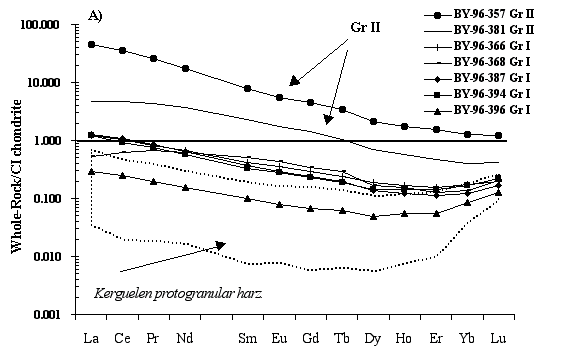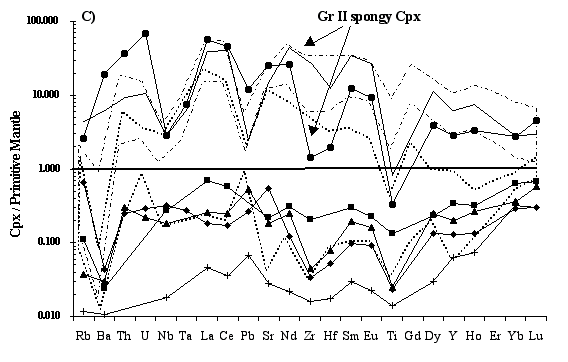G. Delpech 1,2, M. Grégoire1,3, J.Y Cottin1,2, G. Michon2 and S.Y O'Reilly1
1: GEMOC Arc National Key Centre, Department of Earth and Planetary
Sciences, Macquarie University, NSW 2109, Australia
2: Département de Géologie, UMR 6524 ´ Magmas et
Volcans ª, Université Jean Monnet, 24, rue du Dr P. Michelon,
42023 Saint-Etienne, France
3: Department of Geological Sciences, University of Cape Town, Rondebosh
7700, South Africa
Mantle xenoliths are common in alkaline lavas flows and dykes from Kerguelen Islands (South Indian Ocean). Previous studies have recognised different types of mantle ultramafic xenoliths, mostly harzburgites and dunites. A new type of harzburgite has been discovered at the Lac Michèle locality (NW Kerguelen) and resembles poikiloblastic harzburgites from Borée (MCF, France). The Kerguelen poikiloblastic harzburgites show large olivine grains (up to several centimeters) that may contain inclusions of orthopyroxene. Orthopyroxene displays irregular forms with curvilinear grain boundaries and clinopyroxenes are rare (<3%) and small. These poikiloblastic harzburgites can be divided into two types on the basis of their microstructures and composition. The first group (Gr I) is represented by harzburgites showing clinopyroxene closely associated with orthopyroxene-spinel clusters and with rare disseminated clinopyroxene in the peridotitic matrix. The second group (Gr II) consists of harzburgites characterised by spongy clinopyroxenes around small reacted vermicular spinels.
The petrogenesis of the poikiloblastic hazburgites may be explained by a two stage evolution model. Whole-rock and consituent mineral major element compositions (Mg# Ol = 90.7-92.2, Mg# Opx=91.5-93, Mg# Cpx= 91.4-94.8, CaOWR< 1wt %, Al2O3WR< 1.03wt %) and very low trace-element contents (fig. 1) indicate refractory compositions which provide evidence that these xenoliths are residues of an extensive partial melting event probably related to the thermal erosion of the oceanic lithosphere by the Kerguelen plume.
However, LREE enrichments as shown on whole-rock and clinopyroxene patterns require incompatible trace element addition by metasomatisc agents. Trace-element contents in clinopyroxene from Gr I poikiloblastic harzburgites can be ascribed to percolation of various amount of basaltic melt through the peridotitic matrix with associated melt/rock reaction processes. Trace-element patterns of the spongy clinopyroxene exhibit one of the largest LREE (La/YbN CI=12.38-13.37), Th and U enrichments among the Kerguelen xenoliths, and negative Ti, Zr, Hf, Pb, Nb and Ta anomalies compared to Gr I poikiloblastic harzburgites. Calculated theoretical melts in equilibrium with the spongy clinopyroxenes have extreme enrichments in LREE and Th, U and are very depleted in HFSE. This is interpreted as the result of metasomatism by small volumes of volatile and CO2 rich fluids percolating through Gr II poikiloblastic harzburgites.
Nevertheless, Kerguelen poikiloblastic harzburgites cannot be related
to the model proposed by Xu et al. (1998) for the poikiloblastic harzburgites
from Borée. These were interpretated as the result of extensive
melt percolation-reaction during erosion of the lithosphere by an upwelling
plume. In the Kerguelen samples, constituent minerals are too magnesian
and trace-element contents too low for this distinctive microstructure
to have formed by extensive percolation by alkaline melts. Sr, Nd isotopic
analyses of cpx and whole-rock Os isotopic compositions are currently being
processed in order to better understand the formation of the Kerguelen
poikiloblastic harzburgites.
Xu ,Y.,-G., Menzies, M., A., Bodinier, J.,-L., Bedini, R., M., Vroon,
P., and Mercier, J.,-C., C. (1998). Melt percolation and reaction atop
a plume: evidence from the poikiloblastic peridotite xenoliths from Borée
(Massif Central, France). Contrib Mineral Petrol, 132, 65-84.
McDonough, W., F. and Sun, S.,-s. (1995). The composition of the Earth.
Chemical
Geology,120, 223-253.

Figure 1 : A) Whole-rock trace-element patterns for poikiloblastic harzburgites
(Sun and McDonough, 1995). Field for whole-rock protogranular harzburgites
from Kerguelen for comparison. B ) Trace-element patterns of cpx from poikiloblastic
harzburgites with fields for Kerguelen protogranular and poikilitic harzburgites.
C) Primitive mantle-normalised trace-element patterns for clinopyroxenes
of poikiloblastic harzburgites with fields for Kerguelen protogranular
and poikilitic harzburgites.



 GEMOC ARC National Key Centre
GEMOC ARC National Key Centre